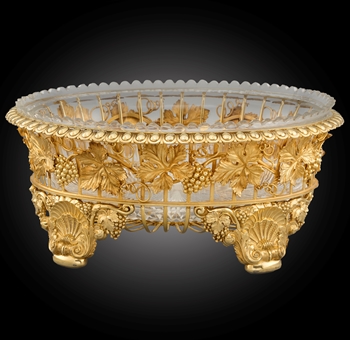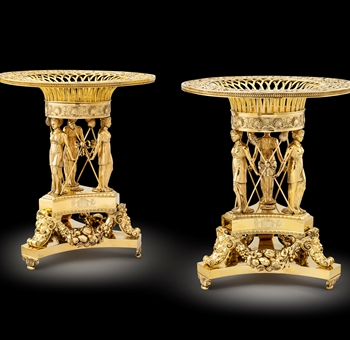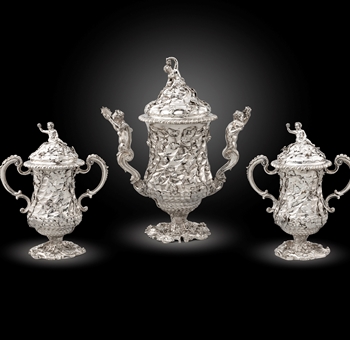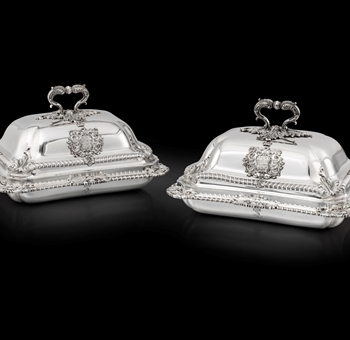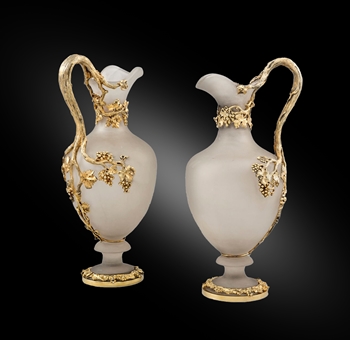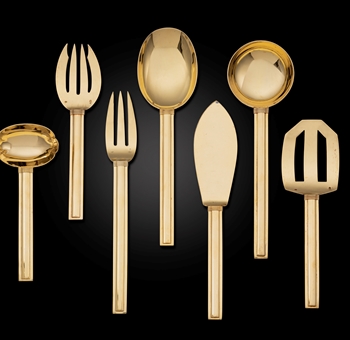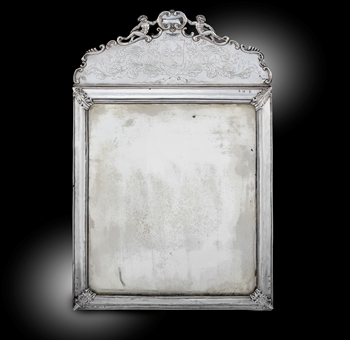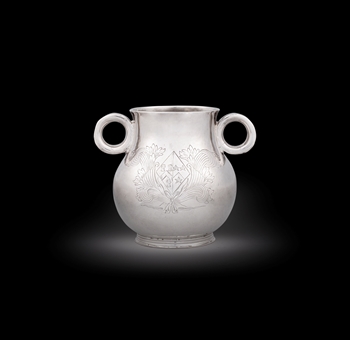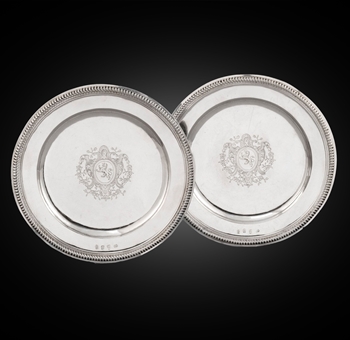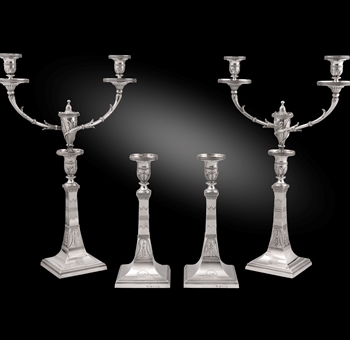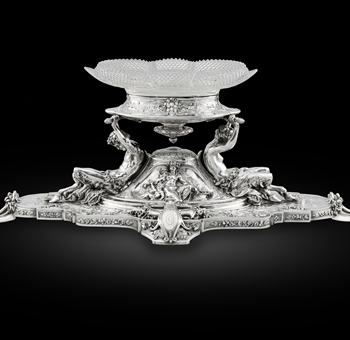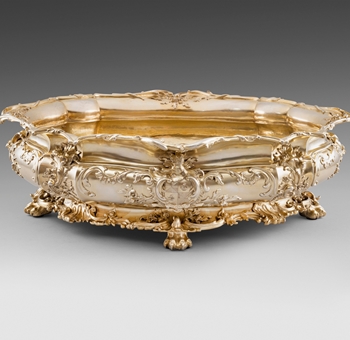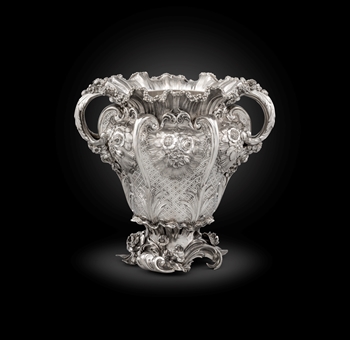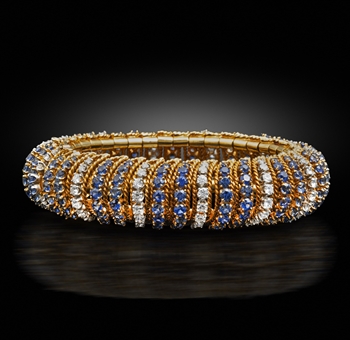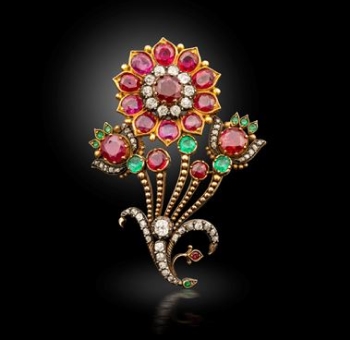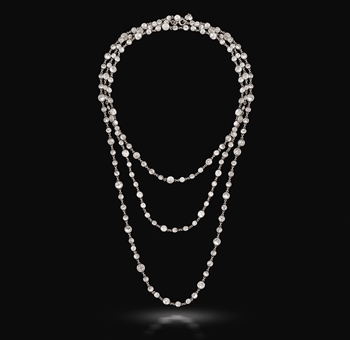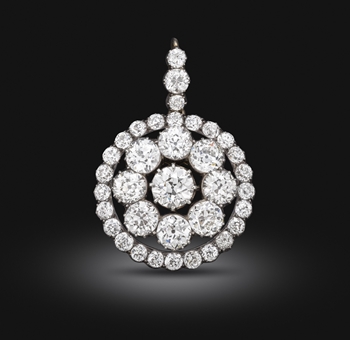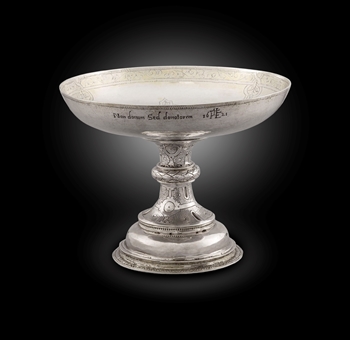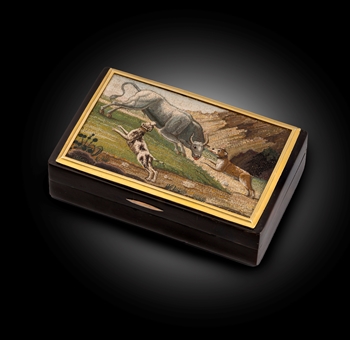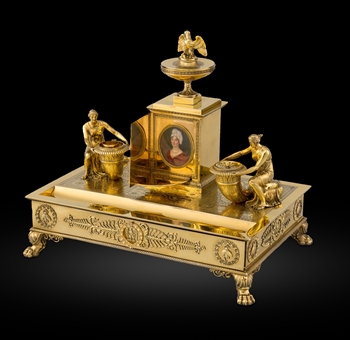Christopher Lawrence
There were no relaxed student days at art college for Christopher. He started at the bench straight from school aged 15¾, leaving home around 6am. Three days a week during term time he went to evening class and didn’t arrive home until 11pm. Inspired by Reginald Hill, his goal as an apprentice was to become a designer-silversmith. He achieved his ambition. Christopher Nigel Lawrence was born in 1936. It is alleged that he started to use a hammer, the smiths’ primary tool, at the tender age of three years when he nailed wood to the floor. At school it soon became clear that his inclination was towards using his hands as opposed to the academic. Much to his parents’ consternation, he did not pass his 11+ examination to his local grammar school, so went to his local comprehensive. In retrospect, this was possibly the better move for in his second year he began metal work classes and soon found that he had a natural aptitude for working with metal. Unfortunately, his metalwork teacher was an engineer as opposed to a craftsman, so he did not benefit from being well-instructed, but clearly, he realised that he had a talented pupil and gave him a completely free hand to experiment. It was evident that his parents were thinking about his future, even if Christopher was not. It was suggested that Christopher may like to go up to town for the day with the scoutmaster at the church where his father was Minister. He went by train with Norman Vander from Westcliff-on-Sea to London to the silversmithing company of C J Vander. There were 20 people working away with metal and Christopher Lawrence was spellbound. On the way home, Norman Vander asked him if he would like to be a silversmith. The Lawrence could not believe his luck and it was agreed that he start his training aged 15¾ on a weekly wage of £1 17s 6d (£1.87½) a week. He had day release on a Wednesday to the Central School of Arts and Crafts (CSAC) and on three days a week evening classes there from 7-9pm three days a week. He officially became an apprentice the following year to Bill Cassley, who was a flat work – or a tray maker in common parlance – which is the most difficult hammer work in the silversmiths’ repertoire. However, it was not plain sailing for Christopher. Mr Cassley had worked through the 1930s recession and in common with other craftsman of the period who had done so, their insecurity manifested itself in being reluctant to pass on everything they knew, in case the person they were teaching was considered a candidate for their job. He was also a smoker, which meant that each winter he routinely was off ill with bronchitis for six weeks. In Cassley’s absence the other flat worker at Vander’s should have taken him under his wing. However, Christopher was perceived by him to be hand in glove with Norman Vander as it was through him that he got the job. The working environment was certainly stacked against Christopher. Imagine his feeling when a commission arrived during Cassley’s absence to make meat and fish dishes for a bank. The task was given to Christopher. He explained, ‘My first task was to make a three-foot-long salmon dish. I was 18 and knew I was being tested to the absolute limit. When you make a piece of metal of this length, all the tension is down to length and virtually none in the width. Every time you hit the metal it goes like a banana. Over those five or six weeks on the order, I grew up. By trial and error, I learnt to control the metal. After that I got all the large dishes to make.’ It was during Reginald Hill’s classes (see the entry for Reginald Hill above) that Christopher decided that he wanted to design as well as make. When he thought the time was right, he asked Norman Vander if he could undertake the company’s presentational drawings. Initially, the response was negative, until he explained that he would be undertaking the work at home. Christopher said, ‘I wanted the experience. When discussing a commission with a client, you only have one chance and drawings are your showcase. Reggie [Hill] thought this was brilliant. My own ideas began to creep into the designs.’ So, while an apprentice, the young Lawrence had his first taste of designing. He completed his apprenticeship in 1958 and would possibly had stayed at Vanders had Norman Bassant decided not to return after his National Service to R E Stone’s (where he had been an apprentice) and instead switch to C J Vander where he was better paid. Norman suggested that as Christopher had mastered flat work he now needed to do the same with hollow raising and planishing. He encouraged him to apply to R E Stone. He did so and got a job. Norman Vander was far from pleased, but Christopher was over the moon. ‘Stone was so puritanical that everything was raised – even if it could be spun. Brilliant, absolutely brilliant!’, he still enthused 50 years later. By his mid-20s, Christopher Lawrence had gained superb experience at the bench, some design experience and for the cherry on the cake he had won a Jacques Cartier Award, the UK’s premier craft prize. He received it for making a rose bowl designed by Alex Styles. Meanwhile, at Tottenham Court Road, Gerald Benney, who was Christopher’s senior by six years, had been in business for half a dozen years or so. Although the business was growing, Gerald only employed one craftsman. Having secured the commission to make the silver for Coventry Cathedral, he was in need of the skills of another silversmith and one who excelled at flat work and who could make the Cathedral’s large bread plates. Christopher Lawrence was the obvious choice and in turn Christopher leapt at the opportunity, particularly as he would now be working exclusively with the contemporary as opposed to the traditional. There is no doubting that the two formed an excellent working relationship as well as mutually earning the greatest respect for each other. At times there appears to have been a wish to push the craftsman’s technical boundaries to their absolute limits. In 1965 Christopher won his second Cartier Award for making the mace, which incorporated fluting, Gerald designed for the University of East Anglia. Later Gerald asked Christopher what the ultimate challenge would be for a hammer man. Christopher’s response was ‘Repeating right-angled tapering fluting, rather like the bellows of a concertina.’ Gerald designed a decanter incorporating this feature. Crafted in 18 carat gold it won Christopher his third Cartier Award. Although Christopher was challenged technically at Benney’s and he was in charge of an increasing number of craftsmen in the workshop, there was a dimension from the work that was missing – design. It had been his ambition from his apprenticeship days to be a designer-silversmith and he saw an opportunity. The Benney workshop had been designing silver for Reading Corporation. The Town Clerk at Reading was friendly with his counterpart at Southend-on-Sea, which was the borough in which Christopher lived. Christopher introduced himself to his local Town Clerk and in due course submitted designs. He learnt that Southend was in discussion with other silversmiths, but he did not know their identity. The fact that a local resident was now in the running brought matters to a swift conclusion – Christopher Lawrence won the commission. Unfortunately, one of the other silversmiths was Gerald Benney, but the two men parted on good terms. Christopher established a small workshop in the garden of his home in 1968, but four months later opened a design studio and workshop at nearby Leigh-on-Sea. As well as 30 pieces for Southend (total cost £12,000), he had three other commissions. These included a dinner service for a private client and Reginald Hill’s design work for Tessiers of Bond Street. This was excellent for a new start-up. However, matters soon got much better. Galerie Jean Renet, a new gallery in Old Bond Street devoted to contemporary silver and jewellery held a large exhibition of his work in 1970. It was a great success. Large exhibitions in Europe were held in 1971 and 1972 while in 1973 The Worshipful Company of Goldsmiths staged a one-man show to commemorate ‘five years of meteoric artistic and commercial development’. The Lawrence workshop by the time had an impressive number of very fine craftsman. Christopher Lawrence’s work was already generating considerable interest in the media. This exhibition gave his exposure a further boost. The highlight of the exhibition was part of a 600-piece dinner service for a prince from the Middle East. Norman Bassant, who was now working for Christopher, was awarded the Jacques Cartier award for the centrepiece. Then there was a multi-colour 18 carat gold perfume bottle secreted within four caskets of a pumpkin form. This was in multi-colour 18 carat gold set with gems and incredibly weighed 140 ounces. Add to this a good array of innovative domestic designs as well those with the classical Lawrence subtle lines and shapes and beyond doubt the 1970s was an era when works by Christopher Lawrence were riding high. The demand for Christopher’s work was buoyant. Galerie Jean Renet was seeking exclusivity, whereas the likes of C J Vander also wanted him to design for it. A second company was established called the House of Lawrian. This was a silver retail and wholesale business as well as a provider of design services. It was managed by Christopher’s oldest brother, but unfortunately not very well. While Christopher picked up the pieces, it was at a cost. At its zenith, there was a workforce of 20. To keep his craftsmen together, Christopher took the lease of a workshop at Southend, renting space to those who wanted to stay with him, but working as subcontractors as opposed employees. Christopher was also looking for a cash generator to provide him with liquidity. Stuart Devlin had his eggs, so what could Christopher develop? He found the answer driving round a roundabout enroute from Essex to London when he saw fungi growing. Initially he created botanical specimens for the Galerie Jean Renet and later a range of mushrooms with surprises for the Heritage Collection for a period of six years from the late 1970s to the mid-1980s. While not among Christopher’s favourites, they were, and indeed are still sought. During the 1980s there was a steady flow of commissions into Christopher’s workshop. These were mainly from the UK from City Livery Companies, prestigious institutions and important private commissions together with some work from the Heritage Collection. In the 1990s he made commemorative items for the Bank of England’s 300th anniversary (1994) and later in the decade, limited edition pieces for the Royal Mint. More importantly he started undertaking work in the Middle East, particularly from the Sultan of Oman for whom in 1998 he made a 14-foot high 6-foot-wide silver gilt cake stand weighing a ton. He continued undertaking work in the Middle East during the 21st century. However, his pièce de la resistance was a collaboration with Fred Rich, the enameller, who also was the winner of three Cartier Awards. The piece is a bowl and ewer. Christopher designed the bowl so that it incorporated the most difficult of feats for the flat worker with its rippled water effect making the bowl. Fred continued the aquatic theme by designing a three-sided tilted ewer (made by Christopher) enamelled with reeds and a reed warbler’s nest. This is a masterpiece of the silversmith’s and enameller’s craft.







